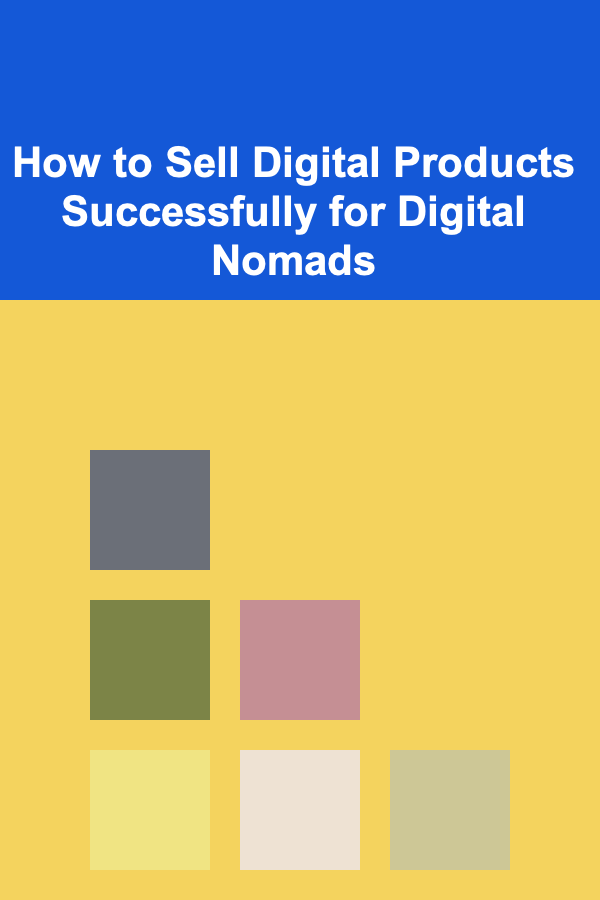
How to Sell Digital Products Successfully for Digital Nomads
ebook include PDF & Audio bundle (Micro Guide)
$12.99$5.99
Limited Time Offer! Order within the next:

The digital nomad lifestyle is becoming increasingly popular, with more and more people opting to work remotely while traveling the world. Whether it's through freelancing, remote jobs, or entrepreneurial ventures, digital nomads are embracing the freedom to work from anywhere. One of the most effective ways for digital nomads to generate income is by selling digital products. In this actionable guide, we'll explore how digital nomads can successfully sell digital products and build a sustainable online business.
Understanding the Potential of Digital Products
Digital products are intangible goods that exist in digital form and can be sold and delivered online. These products don't require physical inventory or shipping, making them ideal for digital nomads who need a scalable and low-maintenance income stream.
Examples of digital products include:
- E-books: Self-published books, guides, and tutorials.
- Online Courses: Educational content, video tutorials, or training programs.
- Designs & Templates: Graphic designs, website templates, or printables.
- Software & Apps: Digital tools and applications.
- Music and Audio Files: Royalty-free music, sound effects, or podcasts.
- Photography & Art: High-quality stock photos, digital art, or illustrations.
- Subscriptions: Membership sites or digital subscriptions for premium content.
These products can be sold globally, allowing you to earn income while traveling without worrying about local restrictions or logistics. Now, let's dive into how to sell these products successfully.
Choose a Profitable Niche
The first step in selling digital products is identifying the right niche. As a digital nomad, you may be passionate about certain topics or have expertise in specific fields, which makes your experience an invaluable asset. However, choosing a niche based on personal interest alone may not be enough; the niche should also be profitable.
Here's how to choose a profitable niche:
- Market Research: Start by researching trends within different industries. Use tools like Google Trends, BuzzSumo, or AnswerThePublic to discover what people are searching for. Look for gaps in the market where demand exists, but the competition is not overwhelming.
- Identify Pain Points: Successful products solve problems. Identify the pain points of your target audience and design your digital product to offer a solution. Whether it's simplifying a complex task, providing entertainment, or improving productivity, make sure your product has a clear value proposition.
- Validate Demand: Before fully committing to a product, test the waters. Launch a landing page, run a small ad campaign, or ask your social media followers for feedback to gauge interest. Crowdfunding platforms or online communities can also help validate your ideas.
- Target Audience: Define who your ideal customer is. Understanding your audience allows you to tailor your marketing messages, product features, and branding to their needs.
By honing in on a profitable niche, you set yourself up for greater success and sustainable sales.
Create High-Quality Digital Products
The quality of your product is paramount when it comes to building a reputation and ensuring repeat customers. Digital products must provide real value to your audience and address their specific needs.
Here are some tips for creating high-quality digital products:
- Provide Clear Solutions: Your product should solve a specific problem. Whether it's an e-book that educates, a template that saves time, or a course that teaches a valuable skill, ensure the product delivers on its promise.
- User Experience Matters: Ensure that your digital product is user-friendly. For online courses, ensure the platform is easy to navigate. For e-books or guides, ensure they are well-organized and visually appealing. The user experience should be seamless and enjoyable.
- Invest in Professional Design: First impressions count. Whether it's a website template, logo, or digital art, make sure your product is professionally designed. Tools like Canva, Adobe Suite, or hiring a freelance designer can elevate the look and feel of your product.
- Test and Improve: Before launching, test your digital product with a select group of users and gather feedback. This will help you spot any issues, improve usability, and ensure your product meets the expectations of your target audience.
High-quality digital products don't only satisfy the immediate needs of customers, they also generate long-term loyalty and positive word-of-mouth marketing.
Set Up Your Digital Sales Infrastructure
Once you've created a valuable digital product, it's time to set up a system to sell and deliver it. Digital sales infrastructure involves creating an online presence, choosing the right e-commerce platform, and ensuring secure payment processing.
Here's what you need to consider:
- E-commerce Platform: Choose an e-commerce platform that supports the sale of digital products. Platforms like Shopify, Gumroad, Teachable, or Etsy are excellent choices for selling digital downloads. Some platforms specialize in certain types of products, such as courses or e-books, so pick one that best fits your business model.
- Payment Gateways: Set up secure payment processing through services like PayPal, Stripe, or other payment processors. Ensure that the checkout process is smooth and trustworthy for your customers.
- Delivery Systems: You'll need to deliver your digital products automatically once customers make a purchase. Platforms like Gumroad or Shopify offer digital delivery systems that instantly send the purchased product to the buyer's email or provide a download link.
- Website or Portfolio: If you want full control over your sales process, consider setting up your own website with WordPress, Wix, or Squarespace. You can sell directly through your website by integrating e-commerce tools like WooCommerce. A website gives you a professional presence and helps build your brand.
A well-designed sales infrastructure ensures that your digital products reach customers smoothly, building trust and improving the overall buying experience.
Marketing Your Digital Products
To sell digital products successfully, you must market them effectively. Here are several proven strategies that will help you reach a wider audience and drive sales:
- Content Marketing: Create valuable content around your product niche. Start a blog, create YouTube videos, or run a podcast that shares helpful information related to your digital products. Content marketing builds trust, drives organic traffic, and helps you establish authority in your niche.
- Email Marketing: Build an email list from day one. Offer a free resource (like an e-book, checklist, or template) in exchange for subscribers' emails. Once you have a list, use email marketing tools like ConvertKit or MailChimp to nurture relationships and send promotions, new product updates, or exclusive offers.
- Social Media Marketing: Use social media platforms like Instagram, Facebook, LinkedIn, or TikTok to promote your digital products. Post engaging content regularly, use hashtags, and consider running paid ads targeting your ideal audience.
- Affiliate Marketing: Partner with influencers or affiliates in your niche to promote your products. Offering an affiliate program can incentivize others to market your products, broadening your reach and increasing sales.
- Search Engine Optimization (SEO): Optimize your website and product pages for search engines to drive organic traffic. Focus on keyword research, creating high-quality content, and building backlinks to improve your search engine rankings.
Effective marketing is all about consistency, providing value to your audience, and testing different approaches to see what resonates best with potential customers.
Optimize for Passive Income
One of the biggest advantages of selling digital products is the potential for passive income. Once your digital product is created and launched, it can be sold repeatedly without significant additional effort. However, you must optimize for passive income by creating systems that work for you around the clock.
Here's how to optimize your business for passive income:
- Automate Sales and Delivery: Use automation tools to handle your sales and product delivery. This will save you time and ensure that your customers get immediate access to their purchases.
- Scale Your Product Line: After your first product is successful, consider creating more products to diversify your income. For instance, if you've created an e-book, you could also create an accompanying course, templates, or membership site.
- Optimize Your Sales Funnel: A well-optimized sales funnel helps you convert visitors into customers and maximize your sales. Use email marketing, retargeting ads, and upsells to increase the lifetime value of your customers.
By building systems that run on autopilot, you can continue to generate revenue while enjoying the flexibility of the digital nomad lifestyle.
Manage Your Digital Nomad Lifestyle While Selling Products
Balancing business operations with travel can be tricky. As a digital nomad, managing your time, staying organized, and ensuring consistent internet access are key to running your online business successfully.
Here are a few tips:
- Set a Routine: While the freedom of being a digital nomad is appealing, a loose routine can lead to burnout. Set aside specific time blocks for work, relaxation, and exploration.
- Reliable Internet: Ensure that you always have access to reliable internet, as it's essential for managing your sales, creating content, and communicating with customers.
- Outsource Tasks: As your business grows, you might want to outsource tasks like customer support, marketing, or content creation. Hiring freelancers or virtual assistants allows you to focus on what matters most: creating new products and enjoying your travels.
Staying organized and efficient will help you maintain a healthy work-life balance while still achieving business success.
Conclusion
Selling digital products as a digital nomad is a rewarding way to earn passive income while enjoying the freedom to work from anywhere. By choosing a profitable niche, creating high-quality products, setting up the right sales infrastructure, and marketing effectively, you can build a sustainable business that allows you to live the digital nomad lifestyle. Stay focused, embrace automation, and continue optimizing your approach as you scale your digital product business. The world is your office, and your digital products can take you far.

How to Choose the Right Dog Boarding at The Ranch
Read More
How to Find the Best Free Online Courses for Career Advancement
Read More
How to Reduce Turnover Rates in Your Rental Property
Read More
How to Stage Your Home with Minimalism to Appeal to Buyers
Read More
How to Use LED Lighting to Transform Your Living Space
Read More
How to Use Lighting to Make a Small Space Feel Bigger
Read MoreOther Products

How to Choose the Right Dog Boarding at The Ranch
Read More
How to Find the Best Free Online Courses for Career Advancement
Read More
How to Reduce Turnover Rates in Your Rental Property
Read More
How to Stage Your Home with Minimalism to Appeal to Buyers
Read More
How to Use LED Lighting to Transform Your Living Space
Read More